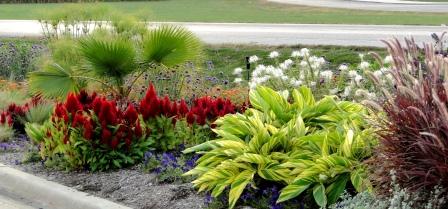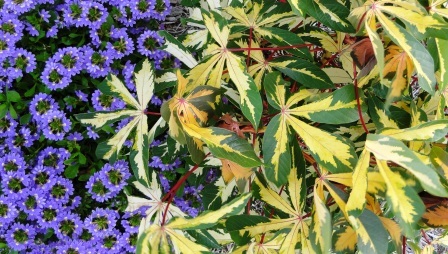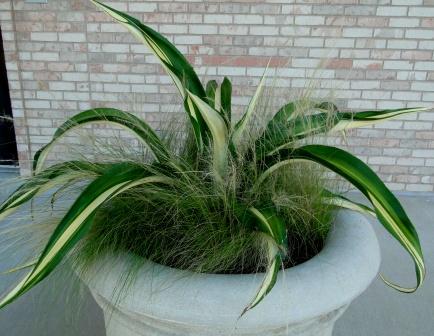
Dramatic gold and green variegated foliage of Canna 'Striata' pops in this display bed with Zinnia elegans ‘Zowie Yellow Flame’ and Z. elegans ‘Uproar Rose’, Rudbeckia hirta ‘Indian Summer’, Persicaria polymorpha, Perovskia atriplicifolia, Cleome ‘Spirit Frost’ and Cleome ‘Spirit Merlot’ and Calamagrostis x acutiflora ‘Karl Foerster’ companions.
Traditionally, GGW Plant Pick of The Month highlights a specific genus or cultivar. I’m going to try something different for October and feature plants with variegated foliage. They function as important accents in my seasonal displays. Note, photos will include companion plant names as well.
The term “variegated” calls to mind childhood memories of our spider plant (Chlorophytum comosum) nestled in its macramé hanger in front of the bathroom window. A combination of green and white markings on the same leaf is indicative of variegation. But variegation in its broadest sense includes leaves with two or more colors, with or without green.

Croton (Codiaeum variegatum 'Petra') with purple heart (Tradescantia pallida). Croton is also striking with Tradescantia zebrina, Helichrysum petiolare or Jewels of Opar (Talinum paniculatum 'Limon').
Nancy Ondra’s wonderful book, Foliage: Astonishing Color & Texture Beyond Flowers (photography by Rob Cardillo), devotes an entire chapter to ‘marvelous multicolors’. She addresses the origins of variegation, patterns, siting, as well as how to use multicolored plants successfully in the garden.
What causes leaves to be multi-colored? Ondra explains that cells found in the leaf normally contain chloroplasts, which typically hold chlorophyll (green) pigments necessary to carry out photosynthesis. When chloroplasts are absent, leaf tissue will be white; if they are present but lacking chlorophyll, those tissues may instead be yellow, pink, red, purple, or other hues due to the presence of other pigments.
Canna ‘Striata’ (shown above), a Missouri Botanical Garden Plant of Merit, Canna ‘Phasion’ (syn Canna ‘Tropicana’) and Croton ‘Petra’ are three of my favorite variegated plants. All perform best in full sun and moist, well drained soil. Although Cannas can often tolerate ‘wet feet’.
Below are photos other variegated plants I worked with this season.

Shell ginger (Alpinia zerumbet) brightens this vignette. Grouped with Pennisetum 'Fireworks', Cleome 'Spirit Frost', Celosia argentea 'Fresh Look Red', Petunia 'Easy Wave Blue', palm (Washingtonia robusta), Verbena bonariensis and Cyperus papyrus. Note, shell gingers typically prefer relief from the afternoon sun. I have had success growing them in full sun by providing supplemental moisture.

Variegated tapioca (Manihot esculenta 'Variegata') paired with Scaevola aemula 'Outback Purple Fan'. This under-used tropical has somewhat woody stems that I have found to be sensitive to high winds, plant in a sheltered location.
A more mature specimen with additional companion plants can be seen here.

Sword-like leaves of mother-in-law's tongue (Sansevieria trifasciata 'Black Gold Extreme') are paired with coleus (Solenostemon scutellarioides 'Curly Lemon Lime').

Bold arching leaves of false agave (Furcraea foetida), a succulent, contrast nicely with the fine foliage of Mexican feather grass (Nassella/Stipa tenuissima). The plants have similar cultural requirements (full sun, dry conditions) making them a perfect pair for this simple container display.
Note, the plants I have chosen to highlight in this post are considered annuals in my USDA zone 5 gardens.
If this is your first time visiting GGW Plant Pick of The Month and you’d like to participate, here is how it works. Simply post your comments below and link to your own site where you’ve posted photos of variegated plants and comments about your experiences working with them. Notes regarding successful planting combinations are especially welcome!
